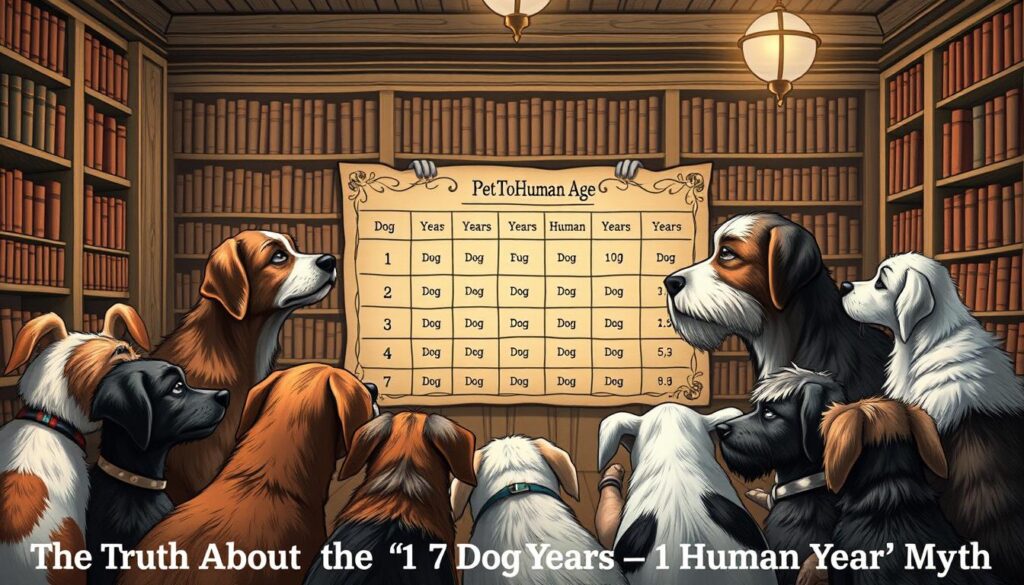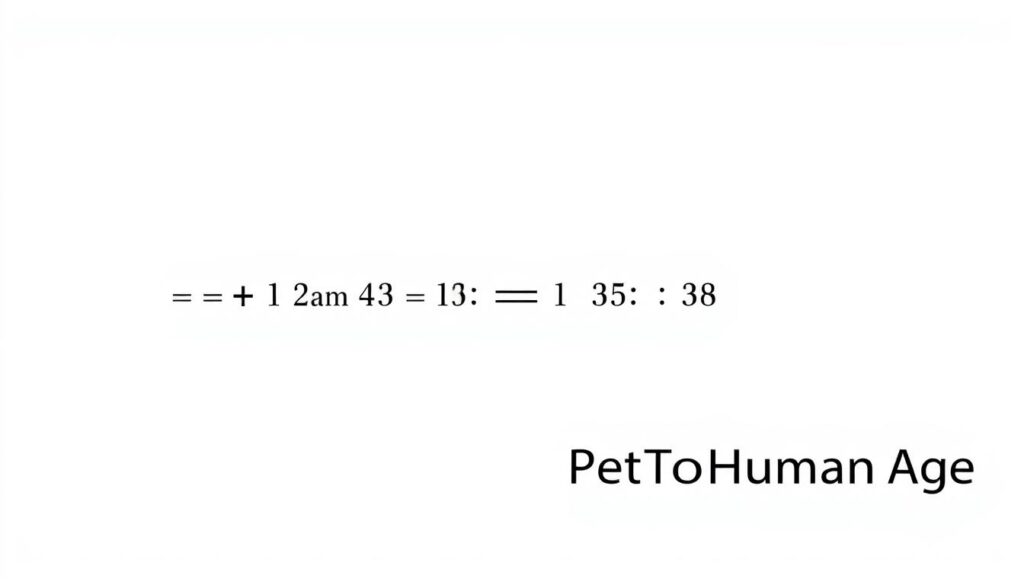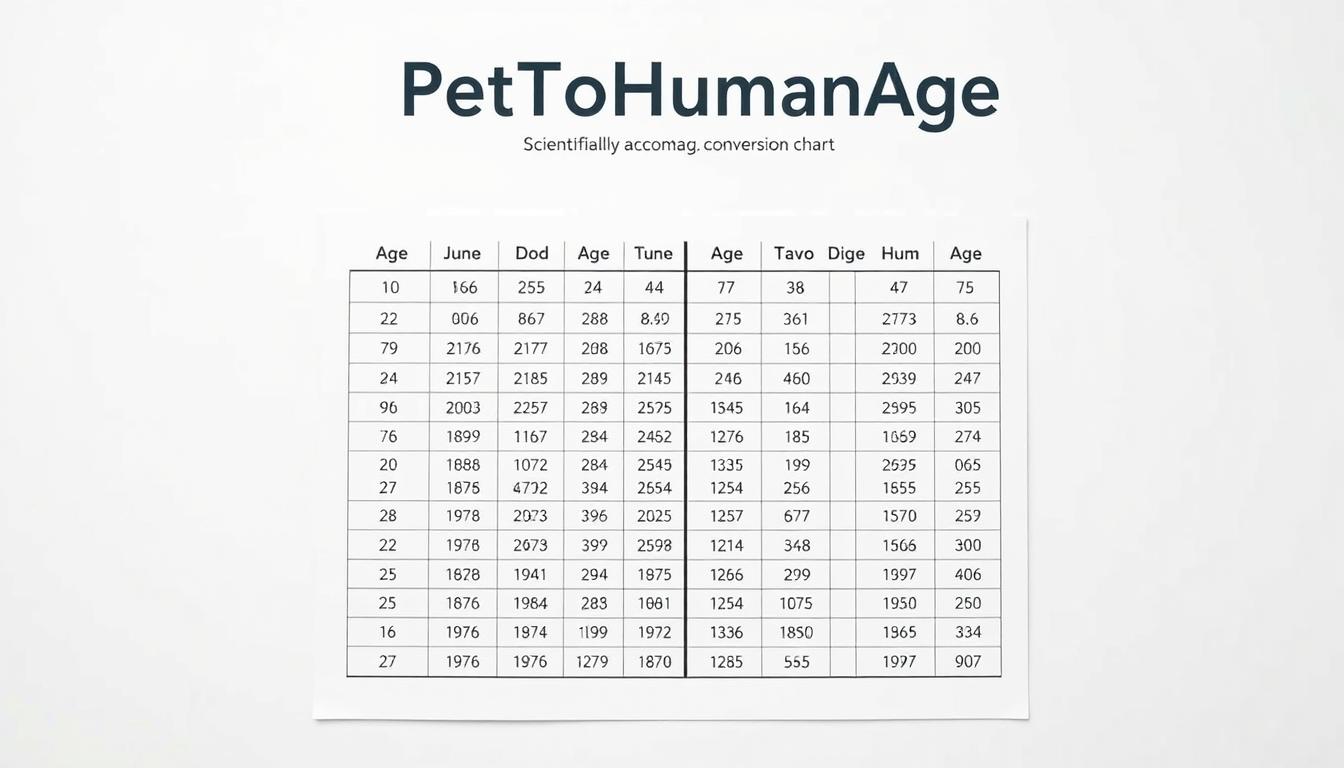Ever wondered about your furry friend’s age compared to yours? The old “7:1 rule” suggests one human year equals seven for a dog, but this idea is outdated. Research shows it’s far more nuanced.
This method originated in the 1950s as a marketing tactic, not science. Modern studies reveal that dogs age differently based on breed, size, and genetics. Smaller breeds often live longer, while larger ones mature faster.
Accurate age calculation helps tailor nutrition, exercise, and vet care. For example, small pups become seniors around seven, but giant breeds may need special attention by five.
Key Takeaways
- The 7:1 ratio is oversimplified and outdated.
- Size and breed significantly impact aging rates.
- Small dogs typically live longer than large breeds.
- Veterinarians adjust senior care based on weight class.
- DNA changes affect how dog years translate to human years.
The Truth About the “7 Dog Years = 1 Human Year” Myth
Many pet owners still believe the outdated rule that one human year equals seven for dogs. This idea isn’t based on biology—it was a 1950s marketing tactic by veterinarians to encourage annual checkups.

Long before the 1950s, people tried to compare lifespans. A 1268 inscription at Westminster Abbey’s Cosmati Pavement suggested nine dog years equaled 80 human years. This medieval math was closer to reality than the 7:1 ratio.
Modern research, like Kelly M. Cassidy’s canine longevity studies, proves the rule is flawed. Dogs age faster early in life, then slower as adults. Smaller breeds also outlive larger ones, making a single ratio impossible.
Why the Myth Persists
The simplicity of the 7:1 rule makes it stick. But comparing averages—like 70 human years to 10 for dogs—ignores breed, size, and genetics.
| Era | Calculation | Accuracy |
|---|---|---|
| Medieval (1268) | 9 dog years = 80 human years | More nuanced |
| 1950s | 7:1 ratio | Marketing-driven |
| Modern Science | Epigenetic clocks, breed-specific formulas | Highly accurate |
Today, DNA research shows why the myth origin fails. Improved diets and vet care have extended lifespans for both species, but dogs still age unevenly compared to humans.
How to Calculate Dog Years to Human Years Accurately
Modern research reveals a smarter way to compare canine and human aging. Instead of relying on myths, scientists now use DNA methylation—a biological process that tracks cellular aging. This method adapts to breed and size, offering precise results.

The AVMA’s Modern Calculation Method
The American Veterinary Medical Association (AVMA) suggests a tiered approach. Puppies mature rapidly, with the first year equating to 15 human age years. After year two, each canine year adds about 4–5 human years, depending on size.
The 2019 Epigenetic Clock Formula
A UCSD study analyzed DNA methylation in 104 Labradors, creating this formula: human_age = 16ln(dog_age) + 31. Here’s how it works:
- Find the natural logarithm (ln) of your pet’s age using a calculator.
- Multiply the result by 16, then add 31.
- Example: A 5-year-old pup’s human age ≈ 16(1.61) + 31 = 57.
This formula shows why the 7:1 rule fails. A 1-year-old dog matches a 31-year-old human, not a 7-year-old. However, the study focused on Labradors—results may vary for other breeds.
How Old Is My Dog in Human Years? Chart by Size and Breed
Breed and size play crucial roles in determining canine aging rates. Smaller pets often live longer, while larger ones mature faster. This means a chart tailored to weight classes gives the most accurate results.
Small vs. Large Breed Lifespans
Toy breeds like Chihuahuas may reach 15–20 years, but Great Danes average 7–10. Genetics and metabolism drive this gap. Smaller bodies typically have slower cellular aging.
| Size | Dog Age | Human Equivalent |
|---|---|---|
| Small (≤20 lbs) | 7 | 44–47 |
| Medium (21–50 lbs) | 7 | 47–50 |
| Large (51–90 lbs) | 7 | 50–56 |
| Giant (>90 lbs) | 7 | 56–61 |
Interactive Dog Age Chart
Use these milestones to plan care:
- Small breeds become seniors at 10–12 years.
- Large breeds need senior screenings by age 6–7.
- Mixed breeds: Base adjustments on dominant traits.
For precise estimates, try a calculator that factors in breed-specific data. Vets recommend annual checkups after age 5 for larger pets.
Signs Your Dog Is Aging (and What to Watch For)
As pets get older, their needs change—knowing what to watch for keeps them healthy. Look for subtle shifts in their body and habits to catch aging signs early.
Physical Changes
Dental issues often appear first. Tartar builds up by age 3–5, and tooth loss may occur by 10–15. Cloudy eyes or gray fur around the muzzle are also common.
- Coat graying: Starts around the face, then spreads.
- Vision changes: Cloudiness or hesitation in dim light.
- Stiffness: Slower to rise or climb stairs.
Behavioral Shifts
Older pets may pace at night or seem restless. Anxiety increases, and housebreaking lapses can signal cognitive decline.
“Senior dogs often sleep more but less deeply, leading to nighttime wakefulness.”
Health Risks by Breed
Large breeds face joint issues like arthritis earlier. Small dogs may develop heart conditions. Regular vet visits help tailor care.
| Breed Size | Common Aging Risks |
|---|---|
| Small (≤20 lbs) | Dental disease, heart murmurs |
| Large (>50 lbs) | Hip dysplasia, mobility loss |
Track changes with a vet-recommended checklist. Early action improves quality of life as your pet ages.
How to Help Your Dog Live a Longer, Healthier Life
A long, vibrant life for your pet starts with proactive care. Simple daily habits and regular vet visits can significantly impact their well-being.
Diet and Exercise Tips
Nutrition fuels longevity. Choose high-quality food tailored to your pet’s age, size, and breed. Large breeds benefit from joint-supporting supplements, while small dogs need calorie-controlled portions.
- Exercise: 30–60 minutes daily, adjusted for mobility.
- Hydration: Always provide fresh water to support kidney health.
- Treats: Limit to 10% of daily calories to avoid obesity.
Veterinary Care Essentials
Preventive care catches issues early. Core vaccines (rabies, parvovirus) are non-negotiable. Senior pets need bloodwork every 6–12 months to monitor organ function.
“Genetic tests can reveal breed-specific risks, like hip dysplasia in German Shepherds.”
Consider pet insurance for unexpected costs. Policies often cover diagnostics, surgeries, and chronic conditions.
Conclusion: Celebrating Every Stage of Your Dog’s Life
Every moment with your dog is a gift, from playful puppy days to wise senior years. The Dog Aging Project shows how understanding their aging process deepens your bond. Whether they’re zooming around or enjoying slower strolls, each phase brings unique joys.
Senior pets often offer quiet companionship and unwavering loyalty. Research in canine gerontology reveals how proper care can extend their vibrant dog life. Regular vet check-ups and tailored nutrition keep tails wagging longer.
Adopting older pets? Their gratitude shines through every gentle nudge. Use our chart to personalize their routine, ensuring golden years are filled with comfort. Here’s to celebrating every paw print they leave on your heart!
FAQs
Why is the “7 dog years = 1 human year” rule inaccurate?
This old myth oversimplifies aging. Dogs mature faster in early life, and breed size affects lifespan. Smaller breeds often live longer than larger ones, so a one-size-fits-all formula doesn’t work.
What’s the most accurate way to convert dog years to human years?
The American Veterinary Medical Association (AVMA) suggests a refined method: the first year equals ~15 human years, the second ~9, and each year after varies by breed size. Scientists also use DNA methylation (epigenetic clocks) for precision.
Do small dogs really age slower than large dogs?
Yes! Smaller breeds like Chihuahuas often live 15+ years, while giant breeds like Great Danes average 7–10. Genetics and growth rates play a big role in aging differences.
How can I tell if my dog is entering their senior years?
Watch for gray fur, slower movement, weight changes, or dental issues. Behavioral shifts—like less interest in play or more sleep—can also signal aging. Regular vet check-ups help catch early signs.
What’s the best diet for an aging dog?
Senior dogs need high-quality protein, joint-supporting nutrients (like glucosamine), and controlled calories. Ask your vet for breed-specific recommendations, especially if your pet has health issues.
How often should senior dogs visit the vet?
Twice-yearly check-ups are ideal for dogs over 7 (or 5 for large breeds). Bloodwork and dental exams become crucial to monitor organ health and prevent issues like arthritis or diabetes.
